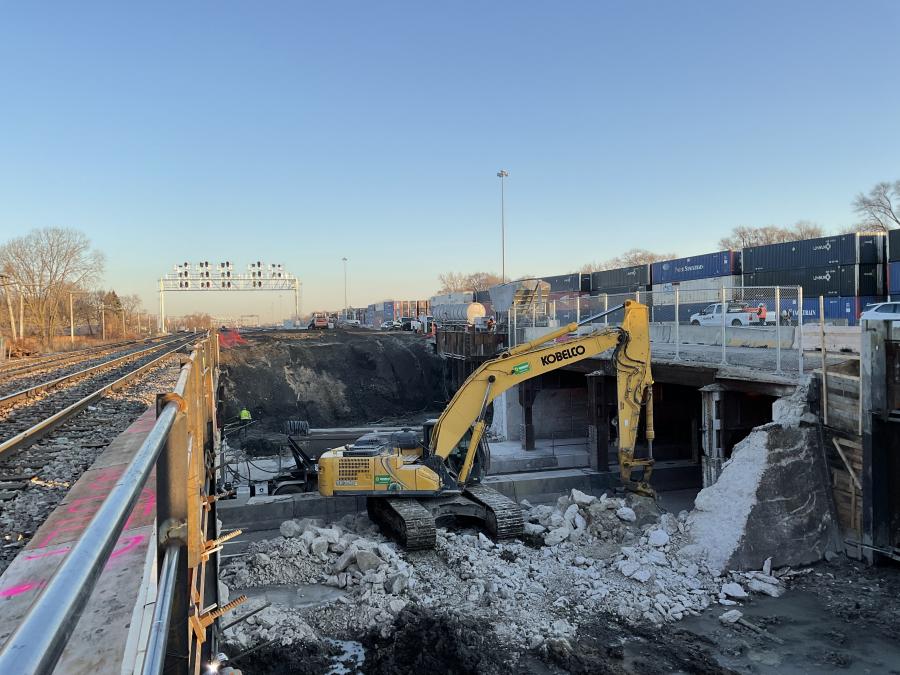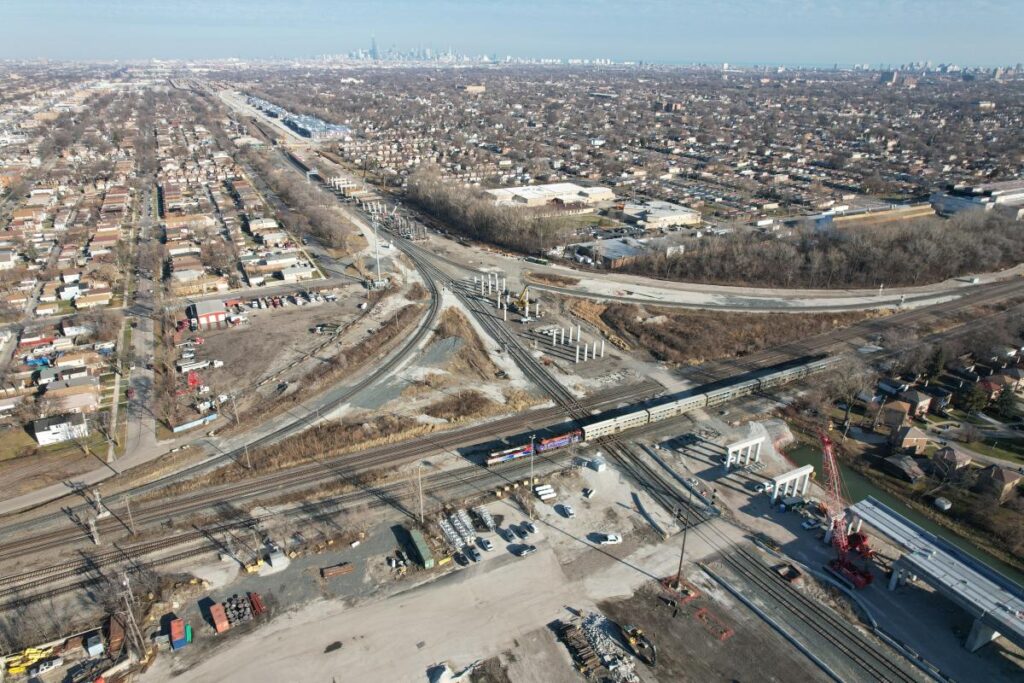Photo courtesy of CSX Transportation
Inc.
A multi-faceted $300 million project aimed at untangling southside Chicago’s vast railroad and roadway infrastructure is well under way with Stage 1, a critical step in moving forward, completed, and Stage 2 of Phase 3 well under way.
A multi-faceted $300 million project aimed at untangling southside Chicago’s vast railroad and roadway infrastructure is well under construction with Stage 1, a critical step in moving forward, completed, and Stage 2 of Phase 3 well under way.
The 75th Street Corridor Improvement Project (75th St. CIP) is the largest project in the Chicago Region Environmental and Transportation Efficiency (CREATE) Program, a public private partnership including the Federal Highway Administration, the Illinois DOT, city of Chicago DOT and Cook County DOT, as well as private railroad companies. When finished, the project is expected to eliminate 18,500 annual train passenger hours of delay; increase train reliability, speed and capacity; and eliminate congestion, delays and idling for motorists.

Photo courtesy of CSX Transportation Inc.
Last summer, crews completed a $25 million “shoo-fly,” a temporary alignment to the west of the original alignment.
“That is what the CSX operation is currently running on, and it is a temporary alignment to the west of the original alignment,” said Brett Guarino, project manager II, CSX Transportation Inc. “What that does is allow for our trains to continue operating pretty much uninterrupted while we build the new flyover structure. Building that first stage of the temporary alignment, or, in railroad terms, a shoo-fly track, required a lot of coordination with our internal stakeholders. I would say that first stage was probably the biggest obstacle for Stage 2.”
Work on the flyover began in earnest in July 2023. When complete, the flyover is expected relieve a current choke-point for four railway services.
The CSX corridor is the Blue Island Subdivision, which runs along Western Avenue.
“The subdivision meets at grade three other railroads at a total of four tracks,” Guarino said. “So, you have the BRC, Metra and Norfolk Southern meeting at what is known as the 75th Street Interlocking, essentially a large intersection for those four railroads. And just like you would have to stop at a red light and allow the opposing traffic to go through until you have a green light, the same scenario applies at a railroad crossing diamond. So anytime we are stopping our operation to allow other trains to clear, it backlogs in our system, it just backs up the pipeline for everyone else.”
The flyover will take the CSX tracks over a bridge, to “flyover” the other three railroads.
The 75th St. CIP also includes three additional projects, also aimed at relieving congestion and delays in the Chicago neighborhoods of Ashburn, Englewood, Auburn Gresham and West Chatham along two passenger and four freight rail lines.
While a project of this scope would be a challenge in any setting, the busy urban location poses its own issues, but it also comes with some benefits, Guarino said. Because the project is on the southside, as opposed to downtown or the financial district, workers have more space, and because it is a railroad project, shipping and fabrication can be handled within the operation.
Photo courtesy of CSX Transportation Inc.
“CSX self-fabricated 70 percent of the bridge steel for the flyover at our own network bridge fabrication facility in West Virginia and we shipped all of those bridge spans by rail from our shop in West Virginia, right up to the project site in Chicago,” Guarino said. “Our project staging site at the south end of the project is the CSX Forest Hill yard and as our company has not used the Forest Hill yard in several years, we have used that as we have our construction site offices for our construction management team and the contractor, Granite Inc. It is a material staging and lay down for assets. It allows us to rail ship a lot of materials, the bridge steel, all of the rail ties, all of that type of material has actually been shipped by rail. So that is an advantage — being a railroad project online with the ability to serve ourselves in that capacity.”
The project currently employs about an average of 75 workers daily, with 16 subcontractors on the job, including Ozinga Concrete, which is providing the concrete elements for the project.
“Ozinga is using one of their local ready-mix sites,” Guarino said. “They’re bringing in most of the concrete from Chinatown, so getting that to the site with traffic sometimes can be a little bit tricky, but we are utilizing local resourced materials as much as we can and that is really how we’ve overcome working in an urban environment.”
The flyover is set to be operational by Dec. 31, 2024, with the final restoration and clean-up work set for completion by Sept. 30, 2025. CEG
Read the full article here

